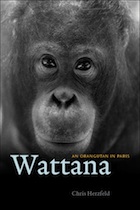
|
In case you missed it...
Wattana. An Orangutan in Paris
The University of Chicago Press
Chicago and London
May 2016
Translated by Oliver Y. Martin and Robert D. Martin
She likes tea, sews, draws on papers, and is a self-taught master of tying and untying knots. But she is not a crafty woman of the DIY set: she is Wattana, an orangutan who lives in the Jardin des Plantes Zoo in Paris. And it is in Paris where Chris Herzfeld first encounters and becomes impressed by Wattana and her exceptional abilities with knots. In Wattana: An Orangutan in Paris, Herzfeld tells not only Wattana's fascinating story, but also the story of orangutans and other primates - including bonobos, chimpanzees, and gorillas - in captivity.
« Herzfeld offers fascinating reflections on a zoo-born ape and her human cultural context. A must-read for anyone interested in the shifting human-animal boundary - including creativity and the aesthetic sense - as illustrated by an exceptionnally talented orangutan. » - Frans de Waal
« For this thoughtful, unusual study of the human–ape ‘interface,’ philosopher of science Herzfeld focuses on a captive orangutan, one of less than 1,000 worldwide. Zoo-born Wattana, given string, cloth and paper at the Jardin des Plantes menagerie in Paris, made elaborate knots and ‘necklaces’ — a skilful use of fibre unsurprising in a tree-dwelling primate that builds complex nests, yet so far seen only in captivity. A trove of gripping research. » - Nature
SUMMARY
Introduction
1. The Ménagerie of the Jardin des Plantes
2. Growing Up Among Humans
3. Living at the Zoo
4. An Orangutan Who Can Tie Knots
5. On the Aesthetic Sense in Great Apes
Epilogue
Publisher Website : http://press.uchicago.edu/ucp/books/book/chicago/W/bo18889815.html
Summary, reviews, press, and contents : see PUBLICATIONS
“As Herzfeld points out, field primatologists such as Jane Goodall have followed the stories of individual great apes in the wild, but few have shown a similar interest in the lives of the thousands of great apes living in captivity. Herzfeld seeks to rectify this mistake and acts as spokesperson for Wattana, a female Bornean orangutan whom she met at Paris’ Menagerie of the Jardin des Plantes. Wattana is known for her abilities at knot tying, a behavior she apparently picked up on her own. She is also known for her friendliness and interactivity with her human keepers, which facilitated her transfer from Paris to the Apenheul Nature Park in the Netherlands. By following Wattana’s life, Herzfeld also follows the evolving philosophies of how zoos function and changing theories on the care of exotic animals in captivity, and of the ways apes have adapted to their lives in an environment radically different from that of their wild relatives. This unique look at zoos and animals is highly annotated, leading interested readers to further exploration, yet also extremely accessible for the more casual reader.”
( Booklist)
“Herzfeld, founder of the Great Apes Enrichment Project, follows the life of an orangutan named Wattana who is housed at the Jardin de Plantes Zoo in Paris. Wattana exhibits a strong interest in human pastimes, thanks in large part to her upbringing among human caretakers after being rejected by her mother. Herzfeld describes how Wattana became a talented and avid knot maker: weaving a variety of materials in and out of her cage bars like a giant macramé project, tying knots in careful sequences, and improvising items when no conventional materials could be found. Wattana appears to derive much pleasure from her creative knot work, just one of several highly human behaviors she exhibits. Herzfeld documents her observations of Wattana while offering historical and scientific information about the great apes, both in the wild and in captivity. Scientists, zookeepers, animal behaviorists, and those with similar credentials will find Herzfeld’s book both fascinating and educational.”
(Publishers Weekly)
For this thoughtful, unusual study of the human-ape 'interface', philosopher of science Chris Herzfeld focuses on a captive orang-utan, one of less than 1,000 worldwide. Zoo-born Wattana, given string, cloth and paper at the Jardin des Plantes menagerie in Paris, made elaborate knots and 'necklaces' - a skilful use of fibre unsurprising in a tree-dwelling primate that builds complex nests, yet so far seen only in captivity. A trove of gripping research, somewhat marred by its scattershof presentation.
(Nature)
>> More
<< Back
|